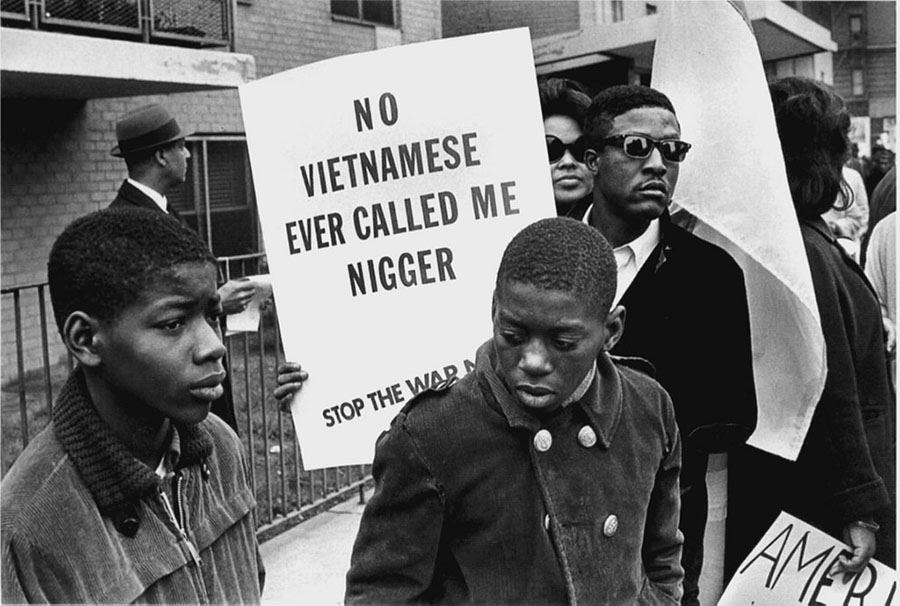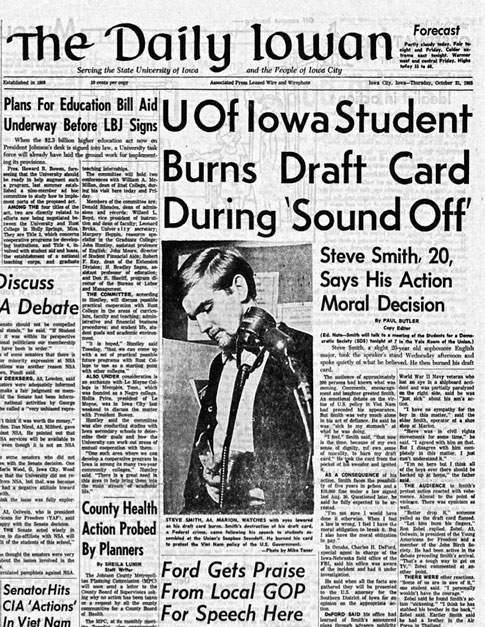Protests
Though
protests against American intervention in Southeast Asia had been taking place
prior, they increased during the late 1960s. After American troops were put on
the ground in 1964, people started to realize that this "conflict"
was becoming an all out war. There were almost 500,000 American troops in
Vietnam by November 1967, and the war cost the US $25 billion dollars a year. The
anti-war sentiment began to transfer from a vocal minority to a significant disillusionment
in the American public. The draft was recruiting up to 40,000 men a month, and
communities were beginning to notice.
At the Lincoln Memorial on October 21,
1967, 100,000 people gathered to protest the war.The photo below gives a scope into the extent of the protest. These protesters were often met with resistance from law enforcement. Hundreds were arrested after
marching to the Pentagon.
 |
| A demonstrator at the October 21 1967 March to the Pentagon |
The draft was a major target of this criticism. Draft resistance
only increased during the 1970s. There were 200,600 legal cases surrounding
induction refusal in 1972.
A Youth-Powered Movement

It must be noted that anti-war protests began on common on college campuses. The new left, which included organizations such as Students for a Democratic Society and the Student Nonviolent Coordinating Committee, was active in anti-war and anti-draft protests. These groups also protested campus and government bureaucracy, as well as the racial and economic injustice the draft sponsored. Many more lower income individuals were drafted, in contrast to their richer counterparts. In addition, Black soldiers made up about 20% of draftees, but only 10% of the United States population. The racial element of the draft is expressed in this photo, which pictures a demonstrator pointing out the disparity between the war and the country's own racial issues.
Much of this activism was in resistance to the draft. The
student body Presidents of 253 universities had written letters of protest to
the White House by 1969. They had promised to refuse induction, like so many
others were doing at the time. Students also began to target selective service
centers and military recruiters on campus with their protests.
Burning Draft Cards
As resistance continued, congress made a law against destroying U.S. selective service
cards. They instituted a penalty of up to five years in prison, as well as a
$10,000 fee. On July 16, 1965, Stephen Smith, pictured in a local newspaper below, was the second person ever
in the country to set fire to his draft card. After joining SNCC, and becoming
"politicized," Smith chose to take action. Smith informed local
newspapers of his decision. Surrounded by a crowd of hundreds of people at the
University of Iowa, he began to speak. "I do not feel that five years of
my life are too much to give to say that this law is wrong,” Smith said, before
removing his draft card from his pocket and lighting it. The crowd responded
with mixed cheers and heckling. Two days later, the FBI took Smith to jail.
However, his actions spurred many more to continue the practice, and it became
a semi-common form of protest.
Conscientious Objectors
In the 1970s, draft resistance had reached an all time high. The
vocal activism of students and others had increased the visibility of draft
resisters, many of whom filed with the selective service as conscientious
objectors. These individuals refused to fight in the military for
religious or moral principles. However, they worked within the selective service system, rather than “dodge”
the draft. Conscientious objectors avoided combatant military service, but was
required to do ‘alternate civilian service.’ More than 170,000 registrants
applied for conscientious objector status between 1965 and 1970. In 1966, Boxer
Muhammad Ali had claimed that military service was against his Islamic beliefs.
However, his local draft board believed him to be insincere and he received a
five year prison sentence. While he remained free on bond until 1971, when his
case was overturned, he was one of many black Muslims who were targeted by the
government. In this video, Ali is arguing his stance with draft-supporters. He again makes the point that the U.S. must do something to combat racial inequality before taking on another country's problems.


Comments
Post a Comment